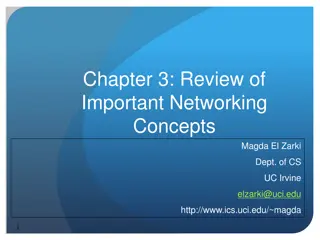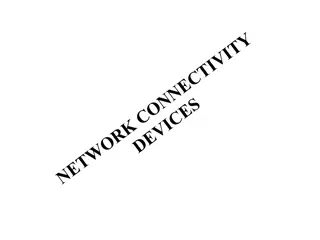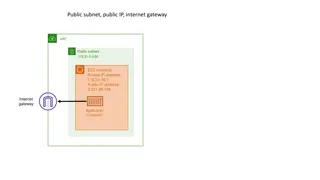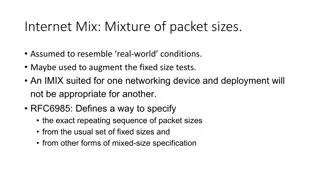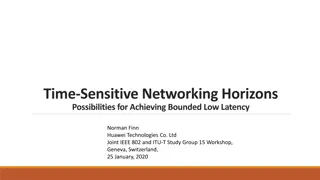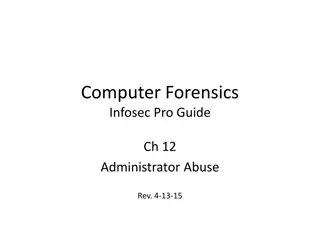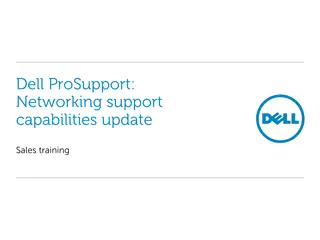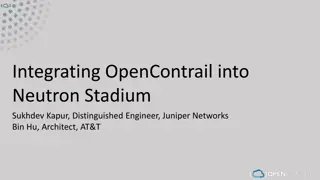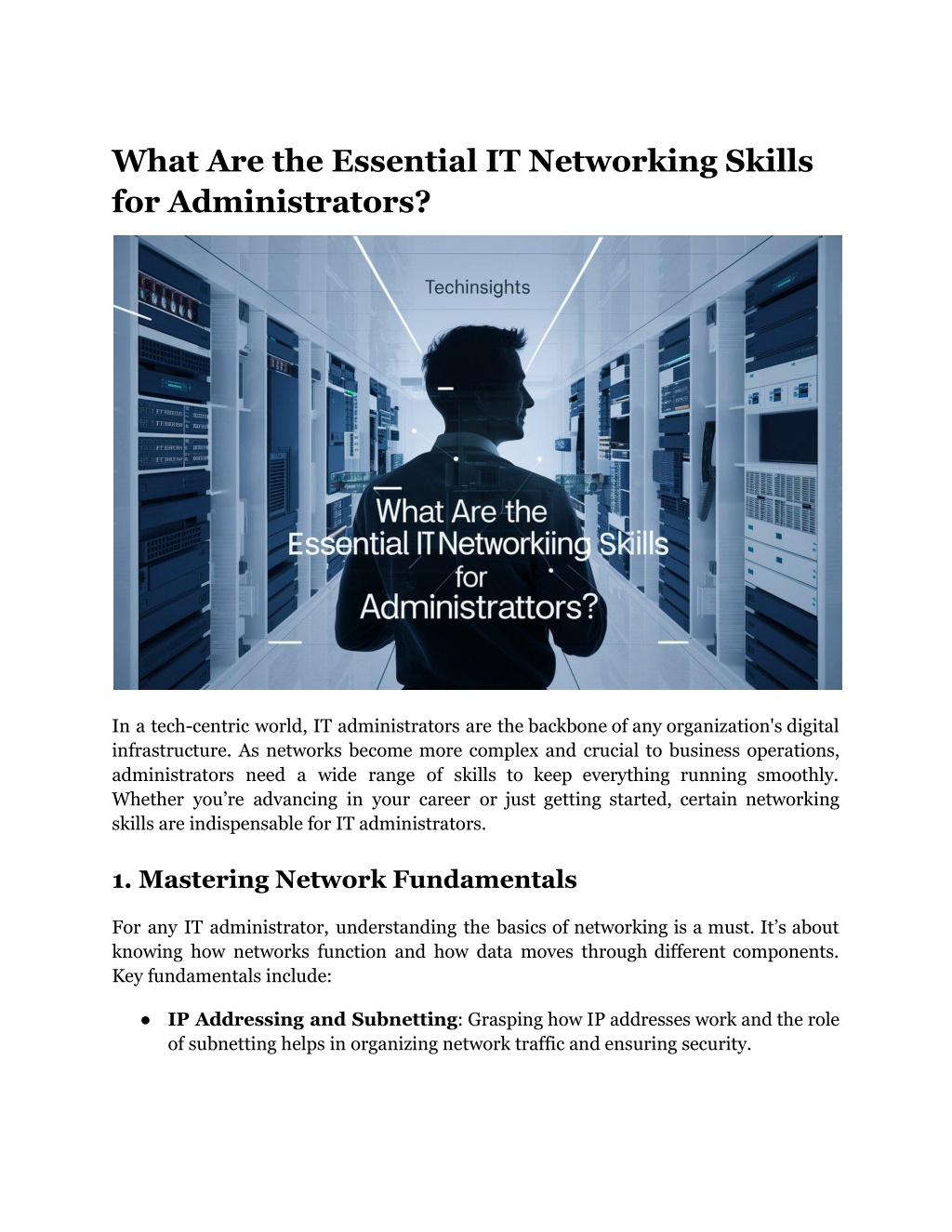
What Are the Essential IT Networking Skills for Administrators
Explore the must-have IT networking skills every admin needs to manage, secure, and optimize networks effectively.
Download Presentation

Please find below an Image/Link to download the presentation.
The content on the website is provided AS IS for your information and personal use only. It may not be sold, licensed, or shared on other websites without obtaining consent from the author. Download presentation by click this link. If you encounter any issues during the download, it is possible that the publisher has removed the file from their server.
E N D
Presentation Transcript
What Are the Essential IT Networking Skills for Administrators? In a tech-centric world, IT administrators are the backbone of any organization's digital infrastructure. As networks become more complex and crucial to business operations, administrators need a wide range of skills to keep everything running smoothly. Whether you re advancing in your career or just getting started, certain networking skills are indispensable for IT administrators. 1. Mastering Network Fundamentals For any IT administrator, understanding the basics of networking is a must. It s about knowing how networks function and how data moves through different components. Key fundamentals include: IP Addressing and Subnetting: Grasping how IP addresses work and the role of subnetting helps in organizing network traffic and ensuring security.
Network Protocols: Familiarity with core protocols like TCP/IP, DHCP, and DNS is essential. These protocols dictate how data is exchanged over the network, making them critical to managing connectivity. Building a solid foundation in network fundamentals helps administrators troubleshoot issues more effectively, making it easier to maintain a stable and secure environment. When partnering with IT Support for Toronto Businesses, having staff skilled in these basics ensures that complex network problems are addressed efficiently. 2. Network Security Knowledge With the growing number of cyber threats, network security is a top priority for IT administrators. It involves protecting the network from unauthorized access, data breaches, and other malicious activities. Key security skills include: Firewalls and Intrusion Detection Systems (IDS): Understanding how to configure and manage firewalls, as well as setting up IDS, helps prevent unauthorized access. Encryption and VPNs: Knowing how to use encryption techniques and Virtual Private Networks (VPNs) safeguards data, especially when transferring sensitive information. Security skills not only help in protecting the network but also in responding to incidents quickly, which is essential for minimizing damage. 3. Troubleshooting and Problem-Solving Skills No matter how well a network is set up, problems will arise. The ability to troubleshoot and solve these issues quickly is what sets skilled IT administrators apart. This involves: Diagnosing Network Problems: Being able to identify the root cause of issues, whether it s hardware failure, software bugs, or configuration errors. Using Diagnostic Tools: Tools like Wireshark, Ping, and Traceroute help in analyzing traffic and identifying bottlenecks. Effective troubleshooting is a combination of technical knowledge and logical thinking. It s not just about fixing immediate problems but also about preventing future ones. Table: Essential Tools for Network Troubleshooting Tool Primary Use Why It Matters
Wireshark Captures network traffic and analyzes Helps packet level identify issues at the Ping Tests connectivity between devices A quick way to check if devices are reachable Traceroute Traces the path data takes through a network Useful for detecting where delays or blockages occur Nmap Scans networks for open ports and devices Enhances security by revealing potential vulnerabilities SolarWinds Network Monitor Monitors performance network Provides prevent and fix issues real-time data to 4. Understanding Virtualization and Cloud Services As businesses move towards cloud computing, IT administrators need to be familiar with virtualization technologies and cloud services. These skills help manage network resources more efficiently: Virtual Machines (VMs): Understanding how to create and manage VMs can help in optimizing server usage and reducing hardware costs. Cloud Networking (AWS, Azure): Familiarity with cloud service providers like Amazon Web Services (AWS) or Microsoft Azure is important for configuring and maintaining cloud-based networks. 5. Configuring and Managing Routers and Switches An IT administrator's role often involves setting up and managing the hardware that supports a network. This includes: Router and Switch Configuration: Knowing how to configure routers and switches is fundamental for creating efficient data flow and connectivity. Quality of Service (QoS): Implementing QoS ensures that critical applications have the bandwidth they need, improving network performance.
6. Knowledge of Managed IT Services Working with Managed IT Services Toronto is not just about outsourcing tasks but understanding how these services integrate with in-house operations. IT administrators should be familiar with: Service Level Agreements (SLAs): Understanding SLAs helps ensure that the company receives the required level of service from third-party providers. Co-managing Networks: Collaborating effectively with managed service providers allows for better network oversight and problem resolution. Table: Comparing In-House IT vs. Managed IT Services Aspect In-House IT Managed IT Services Control Full control over operations Control agreement depends on service Cost Higher upfront costs due to salaries and equipment Predictable costs through service agreements Expertise Relies on in-house staff skills Access to a broader range of expertise Scalabilit y May require additional hires Can scale services up or down easily Availabili ty Limited by team size and work hours 24/7 support is often available 7. Scripting and Automation Skills With networks growing in complexity, automation is becoming a key skill for IT administrators. Knowing how to write scripts can help: Automate Routine Tasks: Tasks like backups, software updates, and network monitoring can be automated to save time and reduce errors. Configuration Management: Tools like Ansible and Puppet use scripts to configure multiple devices consistently.
8. Strong Communication and Documentation While technical skills are critical, the ability to communicate effectively and maintain clear documentation is equally important. This involves: Writing Clear Documentation: Keeping records of network configurations, policies, and changes helps in troubleshooting and onboarding new team members. Explaining Technical Issues to Non-Technical Staff: Administrators often need to explain issues or requirements to stakeholders who may not have a technical background. Wrap Up Being an IT networking administrator isn't just about keeping the lights on as it's about mastering the skills that keep the entire digital infrastructure resilient and adaptable. From network security to troubleshooting, the right skills transform ordinary administrators into indispensable assets. As technology evolves, so must your abilities. Developing expertise in these areas not only future-proofs your career but also ensures your network is always one step ahead of potential issues. Site Article: What Are the Essential IT Networking Skills for Administrators



